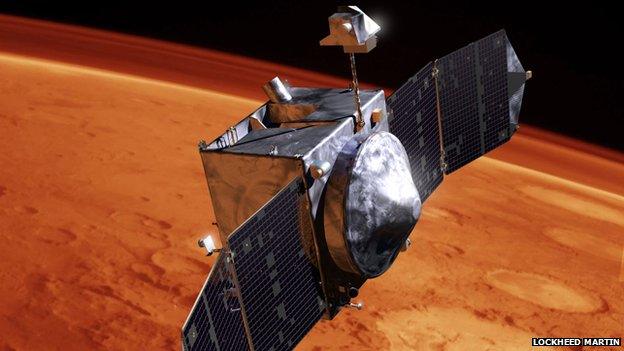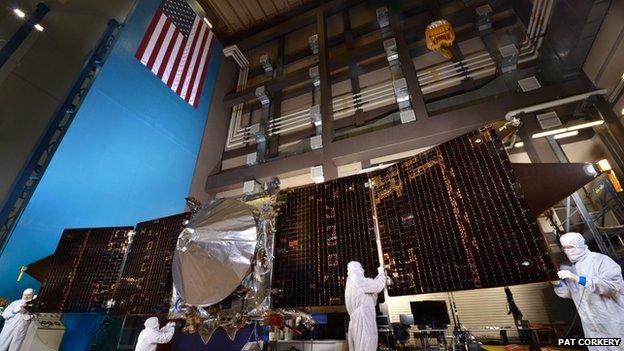Nasa's Maven Mars mission launches
- Published
Watch the launch of Nasa's Maven mission to Mars
The US space agency's (Nasa) Maven mission has set off for Mars.
The orbiter was launched on an Atlas V rocket from Florida's Cape Canaveral Air Force Station at 13:28 local time (18:28 GMT).
Assuming the $671m (£416m) mission stays on track, the probe will have a 10-month cruise to the Red Planet.
Maven is going to study Mars' high atmosphere, to try to understand the processes that have robbed the world of most of its air.
Evidence suggests the planet was once shrouded in a thick blanket of gases that supported the presence of liquid water at its surface. Today, the air pressure is so low that free water would instantly boil away.
Maven was released from the Atlas V's upper-stage some 53 minutes after leaving the Cape Canaveral pad. The probe then had to open its solar panels and orientate itself into a cruise configuration.
"Everything looks good. The signals are coming in fine, and so far the systems that are on are reporting back great. We're heading out to the Red Planet," confirmed David Mitchell, Nasa's Maven project manager.
During the course of the long cruise, Maven will perform four trajectory corrections, with the first scheduled to occur on 3 December.
These manoeuvres will ensure the orbiter arrives at the right place and time to go into orbit around Mars on 22 September, 2014.

Maven also carries equipment to relay data to Earth from Curiosity and other Mars rovers
The present-day atmosphere of Mars, composed mostly of carbon dioxide, is extremely thin, with atmospheric pressure at the surface just 0.6% of the Earth's surface pressure.
The Martian landscape, though, retains channels that were evidently cut by abundant, flowing water - proof that the planet had a much denser atmosphere in the past.
Some of the air would certainly have reacted with, and been incorporated into, minerals at the surface.
But the most likely explanation for its loss is that the solar wind - the great outflow of energetic particles from the Sun - has simply eroded it through time.
This has been possible because, unlike Earth, the Red Planet lacks a protective global magnetic field, which is capable of deflecting the abrasive assault from our star.
Maven (the Mars Atmosphere and Volatile EvolutioN spacecraft) is equipped with eight instruments - some to understand the Sun's influence at Mars; others to investigate the composition and behaviour of the atmosphere. The intention is to measure the rates at which different air molecules are being lost today, distinguishing between the various processes responsible.
Scientists will use this information to get some insights into the history of the Martian climate - from the time billions of years ago when it was warmer and wetter, and potentially habitable to life, to the present environment which is cold and desiccated.
"Most of the loss is thought to have occurred early in Mars' history when the Sun and the solar wind were more intense," said Bruce Jakosky, Maven's principal investigator from the University of Colorado at Boulder.
"The loss rates today are low enough that we're probably not going to see the loss of the entire atmosphere. The reason we are studying it today, even though the loss rates are so much lower, is that we can understand the specific processes that are going on and learn how to extrapolate them back in time."

Maven will execute a number of "deep dips" to directly sample thicker parts of the atmosphere
The 10-month cruise will be used to check out the instruments. And mission scientists also plan some observations of Comet Ison, currently passing around the Sun, which will help with the calibration of those instruments.
But after Monday's successful launch, the anticipation will now build towards September next year and orbit insertion at Mars.
"Maven will be in an elliptical orbit that ranges as far away as 6,220km and as close as 150km," said Guy Beutelschies, the spacecraft's programme manager at manufacturer Lockheed Martin.
"We will also execute a set of operations to dip down into the tenuous upper reaches of the atmosphere to do some direct sampling for approximately a week at a time. These are called 'deep dips' and we do five of them during the primary mission."
That primary mission lasts one Earth year (half a Mars year), after which the science team will need additional funding to continue their investigations.
Nasa, though, fully intends to keep operating Maven long into the future as a data-relay platform for surface rovers like Curiosity.
"If things go nominally, we should have fuel left onboard to keep the vehicle flying for years beyond its design life," Mr Beutelschies explained. "As a reference, Mars Odyssey was launched in 2001 and is still operating."
India launched its Mangalyaan mission to Mars on 5 November but is taking a less direct trajectory to the Red Planet than Maven, which means the US mission should get into orbit just a few days before the other orbiter.
Jonathan.Amos-INTERNET@bbc.co.uk and follow me on Twitter: @BBCAmos, external
- Published22 October 2013
- Published8 April 2013
- Published14 November 2013
- Published2 October 2013
- Published19 September 2013